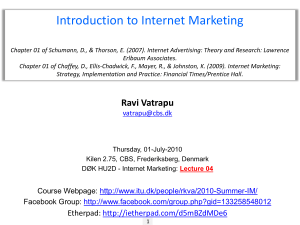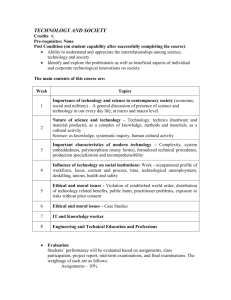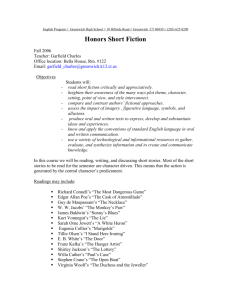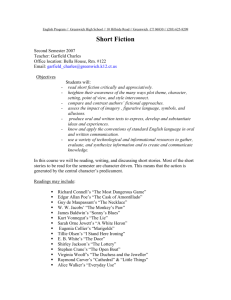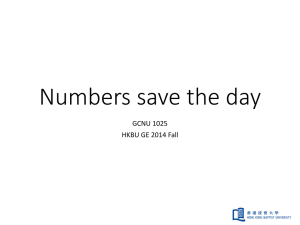Syllabus
advertisement
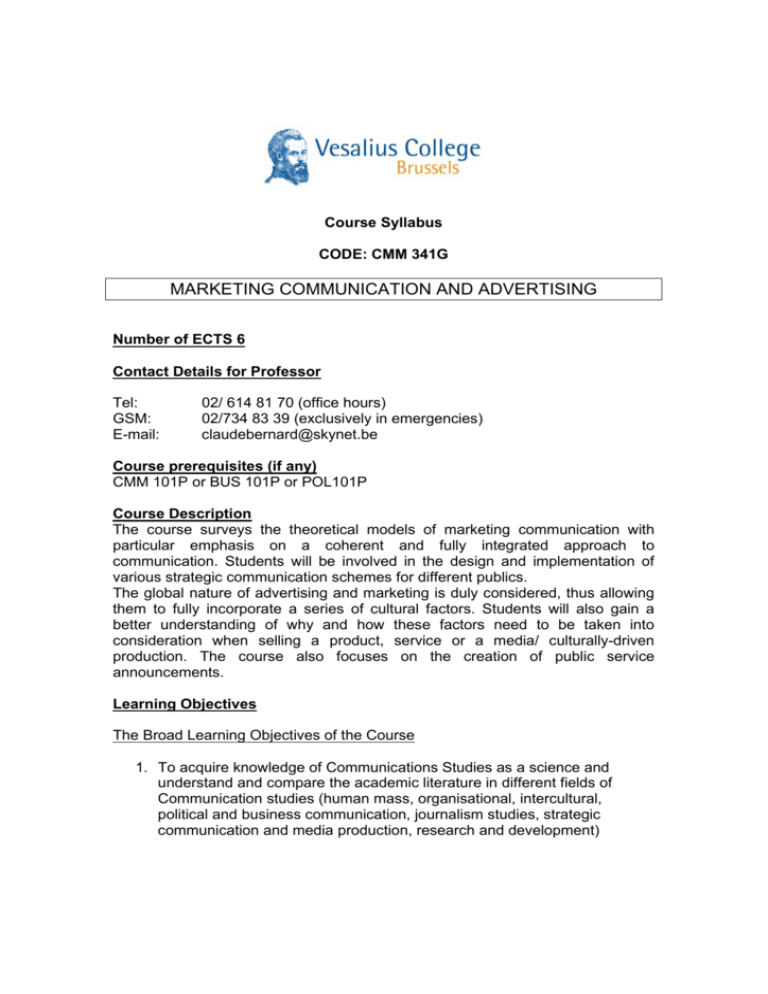
Course Syllabus CODE: CMM 341G MARKETING COMMUNICATION AND ADVERTISING Number of ECTS 6 Contact Details for Professor Tel: GSM: E-mail: 02/ 614 81 70 (office hours) 02/734 83 39 (exclusively in emergencies) claudebernard@skynet.be Course prerequisites (if any) CMM 101P or BUS 101P or POL101P Course Description The course surveys the theoretical models of marketing communication with particular emphasis on a coherent and fully integrated approach to communication. Students will be involved in the design and implementation of various strategic communication schemes for different publics. The global nature of advertising and marketing is duly considered, thus allowing them to fully incorporate a series of cultural factors. Students will also gain a better understanding of why and how these factors need to be taken into consideration when selling a product, service or a media/ culturally-driven production. The course also focuses on the creation of public service announcements. Learning Objectives The Broad Learning Objectives of the Course 1. To acquire knowledge of Communications Studies as a science and understand and compare the academic literature in different fields of Communication studies (human mass, organisational, intercultural, political and business communication, journalism studies, strategic communication and media production, research and development) 2. To promote the understanding and critical refection of regulatory, ethical, technological , political, economic, and cultural factors in communication and different media industries and be able to assess their impact 3. To know and be able to apply the main social science research methods in the design and execution of communication projects, independently or in a team. 4. To be highly skilled in oral and written communication and be able to successfully address diverse audiences. 5. To learn the principles of economics and management of various industries 6. To be able to work effectively in a multinational environment 7. Be prepared to pursue a Master’s degree in all different fields of Communication Studies, get stimulated to lifelong learning and/or attain a high-level occupation in a relevant field. These learning outcomes are in line with the following Discipline learning Outcomes for the Bachelor in Communications Sciences as ratified by the NVAO: DLO 2, DLO 5, DLO 7 and DLO 9 The Specific Leaning Outcomes of the course Acquired Knowledge: To enable the students to describe ways in which communication media as well as techniques and strategies differ between nations according to cultural and political norms. To enhance the students’ ability to access various media organizations operating on a global scale and assess their reach and power To gain an ability to assess various communication models for their effectiveness while factoring the changing socio-political environment To consider ethical principles of applying marketing techniques particularly in the new media environment Applying Knowledge & Judgment: Undertake a comparative analysis Apply knowledge gained in class by analyzing a research study that includes a methodology covered in the course Exhibit the ability to blend creativity with the rigors of a specific brief Describe and consider the ways media techniques differ across the globe according to cultural and political norms Appreciate how a marketing department operates, specifically within the hospitality industry Develop the ability to reflect and react to the communications fields, including with social media and lobbying Perform a comprehensive marketing communication plan within a predetermined budget Draft a 25-30 page media marketing plan related to the promotion of a cultural product and/or a tourism destination using primary and secondary material Enhance students’ ability to access global media. Communication: Present the media marketing plans in a coherent and defensible fashion Defend the plan by stressing the integrated approach used throughout the plan Engage in a structured debate with practitioners and professionals Keep constantly abreast of the new developments and usage of new communication technologies Pitch a concept for any given public service announcement Attitudes: Develop strong networking and leadership skills Develop an aptitude to work in groups under strict deadlines Ensuring that every student feels responsible for the quality of the finished work Desire to apply life-long learning skills COURSE CALENDAR Note that the present calendar is tentative WEEK 1 Introduction to the course and group assignments. Creating a media plan for an audiovisual production: Preliminary Data (1) The importance of positioning. WEEK 2 Preliminary Data (2) Excellence in the filed of advertising (key art and commercials) Read chapter 1 WEEK 3 Media Plan/ The promotional Strand Small group presentations Read chapter 2 WEEK 4 Media Plan: The Advertising Stand Understandings the economics of the global film business Small group presentations Read chapter 3 WEEK 5 The organizational chart of an advertising agency. Evolution in the expected duties and responsibilities among practitioners. (guest speaker) Small group presentations Read chapter 4 WEEK 6 Media Plan: The Publicity Strand Small group presentation Dealing with a client brief.(workshop) Due date for research paper on New Media WEEK 7 Mid-Term Exam The mid-term will cover all the material seen in class. Small group presentations (last week) Creative exercises: conceptualizing and assessing PSA messages WEEK 8 Presentation of Media Plan I (promoting a cultural product in Europe) WEEK 9 Writing creative briefs, conducting in-depth interviews and focus groups WEEK 10 Discussion review and creative workshop Read chapters 6 and 7 WEEK 11 The SOSTAC Plan (Media Plan 2) WEEK 12 Visit to the marketing department of a hotel WEEK 13 Tourism and Hospitality–related campaigns WEEK 14 The art and craft of Public Service Announcements WEEK 15 FINAL EXAM The final covers all the material seen after week 6 Course Materials Textbook Advertising and Promotion (an Integrated Marketing Communication Approach) by Chris Hackely (second edition) Case Studies and Suggested Additional Readings: Articles from specialized magazines and/or sites such as AD Week as well as marketing related articles from cultural magazines or sites such as Variety, The Hollywood Reporter, Daily Screen and Empire Magazine will be distributed in class. Recommended textbook: Integrated Marketing Communications in Advertising and Promotion by Terence Shimp Publisher: Thomson Edition Year: 2012 Please note that the book is available in the library and can also be consulted via the professor. Selected chapters will be distributed in class Videos: A number of videos and documentaries will be watched in class and discussed, such as Viral marketing in Movies, The Blair Witch Case, Creating Iconic Brands: from Mustang to Harley-Davidson, BBC’s The Coca-Cola War. Course support site: Pointcarré Course materials (syllabus, support materials, important messages etc.) will be uploaded on the Vesalius website, Pointcarré. Students are expected to visit the site regularly to keep abreast of course changes and evolutions. Course Assessment The students will be evaluated on the basis of their performance as follows: Tests and quizzes New Media Paper In-class participation Media Plan 1 Media Plan 2 Midterm examination Final examination TOTAL The expected time allocation is as follows: Media Plan 1 and 2: Research Paper: Mid- Terms exam Final exam: In-class participation/ presentations Grading Scale of Vesalius College 5% 10% 10% 20% 20% 15% 20% 100% 60 hours 35 hours 40 hours 40 hours 40 hours Vesalius College grading policy, in line with the Flemish Educational norms, is now as stated follows: Letter grade A AB+ B BC+ C CD+ D F Scale of 20 17.0-20.0 16.1-16.9 15.3-16.0 14.5-15.2 13.7-14.4 13.1-13.6 12.3-13.0 11.5-12.2 10.7-11.4 10.0-10.6 0-9.9 Scale of 100 85-100 81-84 77-80 73-76 69-72 66-68 62-65 58-61 54-57 50-53 0-49 Assessment Criteria A grade of A: Demonstrates outstanding competence. The work reflects a breadth of reading and is based on ample use of sources and s displays vigorous analytical capacities, the central ideas are original and distinctive, substantially developed and supported with details and illustrations. The paper is logically organized and displays careful language use: complete, clear and engaging sentences, correct and distinctive diction. There are NO errors in Standard English usage. A grade of B: Demonstrates good competence. The central idea or ideas are original and clear; the writer shows that there is a point to be made. The central idea or ideas are developed and supported with argumentation. The work demonstrates that the student has covered the basic reading and displays good comprehension. The selection and the use of sources is adequate. The research outcomes and arguments are presented in proper academic form. A grade of C: The work displays a working ability to assemble bibliography and to use resources adequately; reasonable understanding of the core literature and an ability to attempt a scholarly interpretation and analysis of the material read, even if the analysis is incomplete. The work must be presented in a proper academic form, even if there are some flaws in the written or oral expression. A grade of D: The work displays limited reading and incomplete knowledge, flaws in the understanding, inadequate interpretation and limited argumentation. It is presented in adequate English, but with considerate flaws in academic expression. A grade of F: an overall mark below D indicates that not even the minimal standards defined above have been attained. . The Communications Department assesses the outcome of student learning using a variety of indicators. Generally the following principles prevail in evaluating written and oral work. a) Written work: All written work must conform to the academic standards of research and writing (The Writing Center provides information and guidance on this). The following aspects are taken into consideration when assessing students’ written work o o o o o o o o o o o Correct and relevant knowledge of the field Understanding of the issues involved (expressed in a vigorous analysis) Academic writing. This includes the correct use of terminology. Selection of relevant sources Formulation of a thesis statement The ability to use evidence – to build arguments on the basis of the sources the students have accessed. The ability to discriminate between the significant and the trivial. Ability to develop a consistent argument Logical organization of material and a clear structure of the paper. Independent thought: the students’ ability to assess critically the material they have used and formulate their own position on the subject of their research. The quality of writing; the ability to express oneself clearly and consistently, and to write fluently. b) Oral presentations: o Correct and relevant knowledge of the fled o Understanding of the issues involved o Correct use of terminology o Selection of relevant sources o Formulation of position (thesis statement) o The ability to use evidence – to build arguments on the basis of the sources the students have accessed. o The ability to discriminate between the significant and the trivial o Ability to develop a consistent argument o Independent thought: the students’ ability to assess critically the material they have used and formulate their own position on the subject of their research o Eloquence: the ability to express oneself clearly, consistently and fluently o Logical organization and clear structure of the argument. The following criteria will be equally applied in assessing the quality of the written work and the active oral participation of students: Evidence of understanding of the concepts, theories and ideas developed in the course. Active in-class participation, ability to provide a steady stream of ideas and suggestions with regards to the various campaigns discussed Timeliness in handing in the assignments Additional Course Policies Teaching and Learning Methods Interactive professor lectures, expert guest lecturers from advertising agencies, videos, class discussions, creative workshops; Participation Attendance is required and expected, all the more so on account of the fact that the course is primarily given in lecture-series format, relies on guest speakers, and is meant to be quite interactive. Students are therefore not only expected to participate but to actively contribute to the overall dynamic of the class. It is expected that the personally take notes. Because meeting deadlines is considered a crucial skill in the Communications field, unjustified tardiness in handing in assignments and papers will be automatically penalized. Media Plan project instructions Students will work in groups and write two comprehensive marketing communication/ media plans worth a total of 40% of the final grade and meant to promote a tourism destination or a cultural product in a foreign market. The first Media Plan requires students to follow a general template which broadly translates into a “filling the blanks”- type of assignment and is slated to be presented and defended in class on week 8, while the second plan is more in line with a proper report and will use the SOSTAC model as its core The full list of subjects will be provided and discussed in class and pending on the choice of subject, the students number within a group can vary between 2 and 5.students. Research paper instructions Length: On account of the two aforementioned major Media Plan projects, the research paper which focuses on new media marketing and is worth 10% of the final grade, will exceptionally be 3000 words long and is due before the midterm week (week 6). This will allow students to incorporate more readily their findings in the first Media Plan which is due after the mid-term. Students are expected to use a minimum of 12 different academic references and/or media-led sources for their research appear. MLA or Harvard style is required (to be discussed) Research Methods: During the course, students will have the opportunity to make use of a number of specific research methods, including content analysis, surveys, focus groups and in-depth interviews. All assignments need to be provided in a hard copy format on the day indicated on the syllabus. For the two major media plans, NO extensions will be granted. A system will be put in place to ensure that students that do not contribute evenly to the workload are penalized. Presentation and Defense of Research Papers Apart from summarizing the main points of the research, plan or report, students are required to do substantial additional investigation into the subject presented. They must present the information to the rest of the class in the clearest possible manner. Students are required to engage the class in discussion of the issues presented defend their conclusions and provide relevant examples. A good presentation demands insight, effort and professionalism. Academic Honesty Statement Academic dishonesty is NOT tolerated in this course. Academic honesty is not only an ethical issue but also the foundation of scholarship. Cheating and plagiarism are therefore serious breaches of academic integrity. Following the College policy, cheating and plagiarism cases will be communicated in writing to the Associate Dean for Students and submitted to the Student Conduct Committee for disciplinary action. If you refer to someone else’s work, appropriate references and citations must be provided. Grammar, spelling and punctuation count, so use the tools necessary to correct before handing in assignments.
